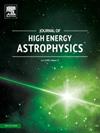Swift J174805.3-244637和IGR J17511-3057的x射线瞬变核星图
IF 10.2
4区 物理与天体物理
Q1 ASTRONOMY & ASTROPHYSICS
引用次数: 0
摘要
本文报道了2023年3月4日和2015年4月8日对中子星低质量x射线双星Swift J174805.3-244637(以下简称Swift J17480)和吸积毫秒x射线脉冲星IGR J17511-3057的NuSTAR观测结果。我们描述了Swift J17480的连续发射,结合了两个软热成分和一个由幂律描述的附加硬x射线发射。我们认为Swift J17480的光谱性质符合软光谱状态。源IGR J17511-3057呈现出由日冕复合辐射特征的硬光谱。两个源的x射线光谱都显示出圆盘反射的证据。我们首次采用自洽反射模型(relxill和relxillNS)来拟合NuSTAR光谱中的反射特征。从最佳拟合的光谱模型中,我们发现Swift J17480的内圆盘半径(Rin)精确地约束为(1.99−2.68)RISCO,倾角为30±1°。我们确定了IGR J17511-3057的内盘半径为> 1.3RISCO,倾角为44±3°。两个光源都需要系统的低倾角。对于旋转速度为4.1 ms的IGR J17511-3057,共旋转半径(Rco)估计为~ 42 km (3.6RISCO),与内盘半径的位置Rin > Rco一致。考虑到圆盘在磁层半径处被截断,我们进一步对源的磁场强度设置了上限。本文章由计算机程序翻译,如有差异,请以英文原文为准。
NuSTAR view of the X-ray transients Swift J174805.3-244637 and IGR J17511-3057
We report on the NuSTAR observations of the neutron star low-mass X-ray binary Swift J174805.3-244637 (hereafter Swift J17480) and the accreting millisecond X-ray pulsar IGR J17511-3057 performed on March 4, 2023, and April 8, 2015, respectively. We describe the continuum emission of Swift J17480 with a combination of two soft thermal components and an additional hard X-ray emission described by a power-law. We suggest that the spectral properties of Swift J17480 are consistent with a soft spectral state. The source IGR J17511-3057 exhibits a hard spectrum characterized by a Comptonized emission from the corona. The X-ray spectrum of both sources shows evidence of disc reflection. For the first time, we employ the self-consistent reflection models (relxill and relxillNS) to fit the reflection features in the NuSTAR spectrum. From the best-fit spectral model, we find an inner disc radius () is precisely constrained to and inclination to for Swift J17480. We determine an inner disc radius of and inclination of for IGR J17511-3057. A low inclination angle of the system is required for both sources. For the source IGR J17511-3057, spinning at 4.1 ms, the value of co-rotation radius () is estimated to be ∼42 km (, consistent with the position of inner disc radius as . We further place an upper limit on the magnetic field strength of the sources, considering the disc is truncated at the magnetospheric radius.
求助全文
通过发布文献求助,成功后即可免费获取论文全文。
去求助
来源期刊

Journal of High Energy Astrophysics
Earth and Planetary Sciences-Space and Planetary Science
CiteScore
9.70
自引率
5.30%
发文量
38
审稿时长
65 days
期刊介绍:
The journal welcomes manuscripts on theoretical models, simulations, and observations of highly energetic astrophysical objects both in our Galaxy and beyond. Among those, black holes at all scales, neutron stars, pulsars and their nebula, binaries, novae and supernovae, their remnants, active galaxies, and clusters are just a few examples. The journal will consider research across the whole electromagnetic spectrum, as well as research using various messengers, such as gravitational waves or neutrinos. Effects of high-energy phenomena on cosmology and star-formation, results from dedicated surveys expanding the knowledge of extreme environments, and astrophysical implications of dark matter are also welcomed topics.
 求助内容:
求助内容: 应助结果提醒方式:
应助结果提醒方式:


